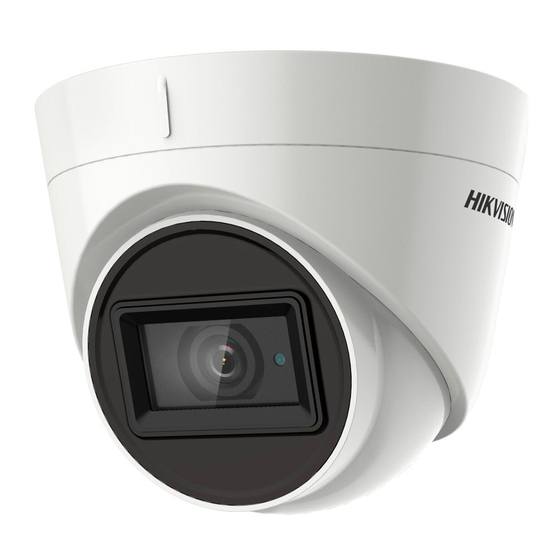
HIKVISION Turbo HD H8T Series User Manual
Turret & dome camera
Hide thumbs
Also See for Turbo HD H8T Series:
- User manual (17 pages) ,
- User manual (15 pages) ,
- User manual (15 pages)
Advertisement
H8T Series Turret & Dome
User Manual
Thank you for purchasing our product. If there are any
questions, or requests, do not hesitate to contact the
dealer.
This manual applies to the models below:
Type
Type I Camera
Type II Camera
Type III Camera
This manual may contain technical incorrect places or
printing errors, and the content is subject to change
without notice. The updates will be added to the new
version of this manual. We will readily improve or update
the products or procedures described in the manual.
TURBO HD
User Manual
Model
DS-2CE78H8T-IT1F
DS-2CE78H8T-IT3F
DS-2CE76H8T-ITMF
DS-2CE57H8T-VPITF
Camera
0100001080730
Advertisement
Table of Contents

Summary of Contents for HIKVISION Turbo HD H8T Series
- Page 1 TURBO HD H8T Series Turret & Dome Camera User Manual User Manual Thank you for purchasing our product. If there are any questions, or requests, do not hesitate to contact the dealer. This manual applies to the models below: Type Model DS-2CE78H8T-IT1F Type I Camera...
- Page 2 Regulatory Information FCC Information Please take attention that changes or modification not expressly approved by the party responsible for compliance could void the user’s authority to operate the equipment. FCC compliance: This equipment has been tested and found to comply with the limits for a Class A digital device, pursuant to part 15 of the FCC Rules.
- Page 3 Safety Instruction These instructions are intended to ensure that user can use the product correctly to avoid danger or property loss. The precaution measure is divided into “Warnings” and “Cautions”. Warnings: Serious injury or death may occur if any of the warnings are neglected.
- Page 4 While in delivery, the camera shall be packed in its original packing, or packing of the same texture. Mark Description Table 0-1 Mark Description Mark Description DC Voltage 1 Introduction 1.1 Product Features The main features are as follows: High performance CMOS sensor ...
-
Page 5: Installation
Note: Press and hold the switch button for 5 seconds to switch the video output. Four kinds of video outputs are available: TVI, AHD, CVI, and CVBS. 1.2.3 Overview of Type III Camera Video Cable Power Mounting Base Cord Switch Pan Adjusting Screw Button Tilt Adjusting... - Page 6 Figure 2-1 Disassemble the Camera 2. Remove the mounting base from the camera body with a flat object, e.g., a coin. 3. Paste the drill template (supplied) to the place where you want to install the camera. 4. Drill the screw holes and the cable hole (optional) on the ceiling/wall according to the drill template.
- Page 7 8. Connect the corresponding cables, such as power cord, and video cable. 9. Power on the camera to check whether the image on the monitor is gotten from the optimum angle. If not, adjust the camera according to the figure below to get an optimum angle.
- Page 8 Figure 2-8 Fix the Mounting Base to the Ceiling Note: The supplied screw package contains self-tapping screws, and expansion bolts. For cement wall/ceiling, expansion bolts are required to fix the camera. For wooden wall/ceiling, self-tapping screws are required. 6.
- Page 9 2.3 Ceiling Mounting of Type III Camera Steps: 1. Paste the dill template to the ceiling. 2. Drill the screw holes and cable hole (optional) in the ceiling according to the drill template. Figure 2-11 Drill Template Note: Cable hole is required, when adopting the ceiling outlet to route cables.
- Page 10 2). Hold the black liner to adjust the pan position [0° to 355°]. 3). Hold the camera body to adjust the rotation position [0° to 355°]. 8. Reinstall the bubble, and tighten the screws. Figure 2-15 Bubble Reinstallation...
-
Page 11: Menu Description
3 Menu Description Purpose: Call the menu by clicking the button on the PTZ Control interface, or call preset No.95. Steps: 1. Connect the camera with the TVI DVR, and the monitor, shown as the figure 3-1. Figure 3-1 Connection 2. -
Page 12: Exposure Mode
1). Click up/down direction button to select the item. 2). Click Iris + to confirm the selection. 3). Click left/right direction button to adjust the value of the selected item. 3.1 VIDOE FORMAT You can set the video format as 5MP@20fps, 4MP@25fps, 4MP@30fps, 2MP@25fps, and 2MP@30fps. - Page 13 B & W (Black and White) The image is black and white all the time, and the IR LIGHT turns on in the poor light conditions. You can turn on/off the IR LIGHT and set the value of SMART IR in this menu Figure 3-4 B &...
-
Page 14: Video Settings
3.4 VIDEO SETTINGS Move the cursor to VIDEO SETTINGS and click Iris+ to enter the submenu. IMAGE MODE, WHITE BALANCE, BRIGHTNESS, CONTRAST, SHARPNESS, SATURATION, 3DNR, and MIRROR are adjustable. VIDEO SETTINGS IMAGE MODE WHITE BALANCE BRIGHTNESS CONTRAST SHARPNESS SATURATION 3DNR MIRROR BACK EXIT... -
Page 15: Motion Detection
3DNR (Digital Noise Reduction) The 3DNR function can decrease the noise effect and deliver more accurate and sharp image. You can set the 3DNR value from 1 to 9. MIRROR OFF, H, V, and HV are selectable for mirror. OFF: The mirror function is disabled. H: The image flips 180°... -
Page 16: Save And Exit
3.7 EXIT Move the cursor to EXIT and click Iris+ to exit the menu without saving. 3.8 SAVE & EXIT Move the cursor to SAVE & EXIT and click Iris+ to save the settings, and exit the menu. UD11203B...












Need help?
Do you have a question about the Turbo HD H8T Series and is the answer not in the manual?
Questions and answers